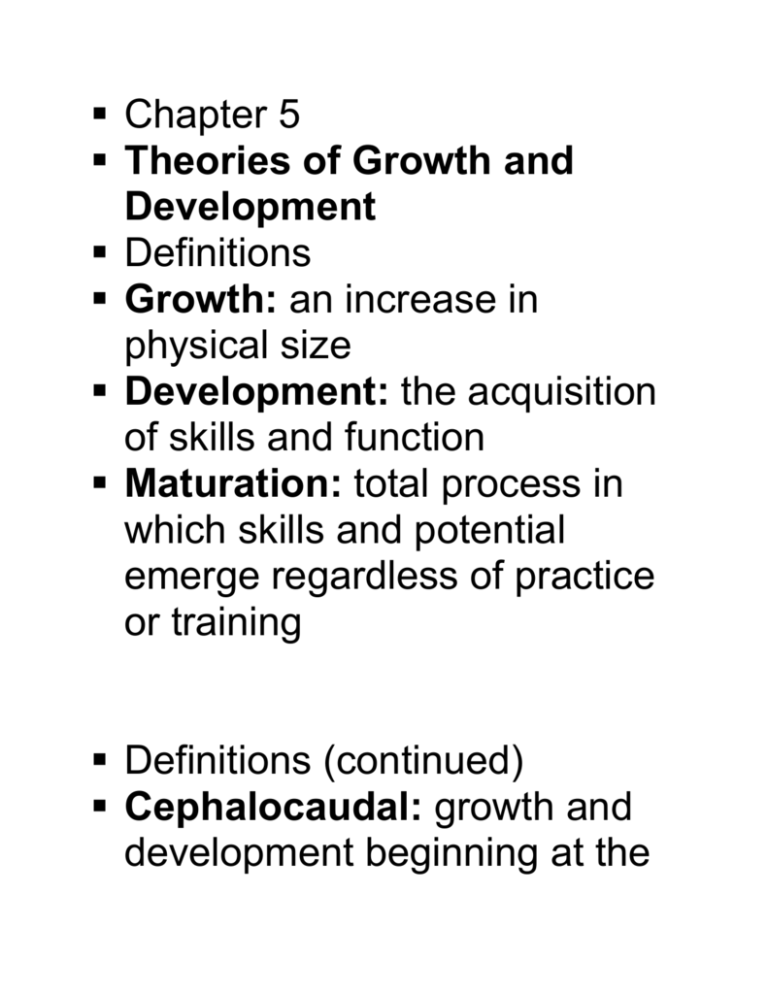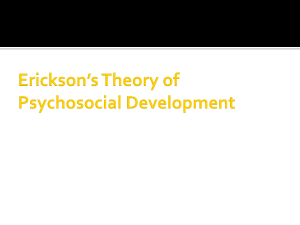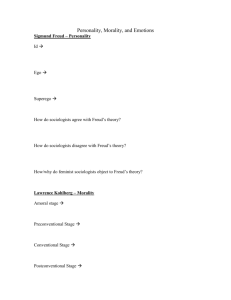Theories of Growth and Development
advertisement

Chapter 5 Theories of Growth and Development Definitions Growth: an increase in physical size Development: the acquisition of skills and function Maturation: total process in which skills and potential emerge regardless of practice or training Definitions (continued) Cephalocaudal: growth and development beginning at the head and progressing downward toward the feet Proximodistal: growth and development progressing from the center of the body toward the extremities Characteristics of Growth and Development Occur in an orderly pattern from simple to complex Continuous processes characterized by spurts of growth and periods of slow, steady growth Progress at highly individualized rates that vary from child to child Affect all body systems, but at different times for specific structures Form a total process that affects a person physically, mentally, and socially Personality Consists of the behavior patterns that distinguish one person from another Several major theories provide key frameworks that help nurses understand different aspects of personality development Sigmund Freud’s psychoanalytical theory Erik Erikson’s psychosocial theory Jean Piaget’s cognitive theory Abraham Maslow’s human needs theory Lawrence Kohlberg’s theory of moral development Freud’s Psychoanalytical Theory Three levels of awareness Conscious: within one’s immediate awareness Subconscious: stores memories, thoughts, and feelings Unconscious: the part of the mind that is closed to one’s awareness Levels of Awareness Freud’s Three Functional Components of the Mind The id: the pleasure principle, or libido. The id demands immediate satisfaction. The ego: the “executive of the mind.” It is the part that is most closely related to reality. The ego may delay satisfaction. The superego: a further development of the ego. It judges, controls, and punishes, and is thought of as a conscience. Freud’s Defense Mechanisms Defense mechanisms are techniques used at all stages of the life cycle to help individuals cope with the threat of anxiety They are used to protect the ego On a short-term basis, they may be helpful Overuse or maladaptive use prevents the individual from achieving personal growth and satisfaction Freud’s Defense Mechanisms (continued) Suppression Rationalization Identification Sublimation Freud’s Defense Mechanisms (continued) Regression Denial Displacement Projection Freud’s Defense Mechanisms (continued) Compensation Undoing Reaction formation Conversion Freud’s Stages of Psychosocial Development Oral stage Birth to the end of the first year of life Mouth is the source of all comfort and pleasure Sucking and biting, using the mouth as the center of gratification Freud’s Stages of Psychosocial Development (continued) Anal stage The end of the first year of life to the third year The second year, the center of pleasure is shared between the mouth and the organs of elimination Toilet training gives the child a sense of self-control and independence Freud’s Stages of Psychosocial Development (continued) Phallic stage Ages 3 to 6 The child associates both pleasurable and conflicting feelings with the genital organs Masturbation and interest in sexual organs are normal Parental disapproval of the child’s preoccupation with the genitals can result in feelings of confusion and shame Freud’s Stages of Psychosocial Development (continued) Latency Ages 6 to about 12 Child’s sexual urges are dormant Sexual energies are being channeled into more socially acceptable means of expression Focus is mainly on intellectual pursuits Peer relationships intensify between same sex Freud’s Stages of Psychosocial Development (continued) Genital stage Begins with the onset of puberty Physical changes prepare the body for reproduction Awakening of sexual attraction and interest in heterosexual relationships Child struggles for independence yet needs parental supervision Erikson’s Psychosocial Theory Broadens Freud’s theory, with eight stages that span the full life cycle from infancy to old age Trust vs. mistrust Autonomy vs. shame and doubt Initiative vs. guilt Industry vs. inferiority Identity vs. role confusion Intimacy vs. isolation Generativity vs. stagnation Ego integrity vs. despair Piaget’s Cognitive Theory Concerned with development of intellect and thought processes Four stages Sensorimotor stage Preoperational stage Concrete operational stage Formal operational stage Maslow’s Human Needs Theory Self-actualization Self-esteem Love and belonging Safety and security Physiological needs Kohlberg’s Theory of Moral Development Level I: Preconventional Thinking (4 to 10 years): the child learns reasoning through the parents’ demand for obedience Level II: Conventional Thinking (10 to 13 years): the school-age child begins to seek approval from society Levell III: Postconventional Thinking (postadolescence): adolescents develop their own moral codes based on the individual’s principles Gilligan’s Critique of Kohlberg’s Theory Carol Gilligan, a critic of Kohlberg’s theory, expresses concern that Kohlberg failed to explore unique female experiences as they pertained to morality Gilligan believes males make moral decisions based on abstract reasoning and principles, whereas females are more concerned with how their decisions affect others Chapter Challenge Name five common characteristics of growth and development List Erikson’s psychosocial theory of development Explain Maslow’s hierarchy of human needs








